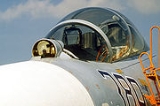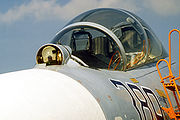
Infra-red search and track
Encyclopedia

Jet aircraft
A jet aircraft is an aircraft propelled by jet engines. Jet aircraft generally fly much faster than propeller-powered aircraft and at higher altitudes – as high as . At these altitudes, jet engines achieve maximum efficiency over long distances. The engines in propeller-powered aircraft...
and helicopter
Helicopter
A helicopter is a type of rotorcraft in which lift and thrust are supplied by one or more engine-driven rotors. This allows the helicopter to take off and land vertically, to hover, and to fly forwards, backwards, and laterally...
s. IRST is a generalized case of Forward Looking Infra-Red (FLIR), i.e. from Forward-Looking to allround situational awareness. Such systems are passive, meaning they do not give out any radiation of their own, unlike radar
Radar
Radar is an object-detection system which uses radio waves to determine the range, altitude, direction, or speed of objects. It can be used to detect aircraft, ships, spacecraft, guided missiles, motor vehicles, weather formations, and terrain. The radar dish or antenna transmits pulses of radio...
. This gives them the advantage that they are difficult to detect. However, because the atmosphere attenuates infra-red to some extent (although not as much as visible light) and because adverse weather can attenuate it also (again, not as badly as visible systems), the range compared to a radar is limited. Angular resolution
Angular resolution
Angular resolution, or spatial resolution, describes the ability of any image-forming device such as an optical or radio telescope, a microscope, a camera, or an eye, to distinguish small details of an object...
at short ranges is better than radar due to the shorter wavelength
Wavelength
In physics, the wavelength of a sinusoidal wave is the spatial period of the wave—the distance over which the wave's shape repeats.It is usually determined by considering the distance between consecutive corresponding points of the same phase, such as crests, troughs, or zero crossings, and is a...
.
Early systems
The first use of an IRST system appears to be the F-101 VoodooF-101 Voodoo
The McDonnell F-101 Voodoo was a supersonic military jet fighter which served the United States Air Force and the Royal Canadian Air Force...
and F-102 Delta Dagger
F-102 Delta Dagger
The Convair F-102 Delta Dagger was a US interceptor aircraft built as part of the backbone of the United States Air Force's air defenses in the late 1950s. Entering service in 1956, its main purpose was to intercept invading Soviet bomber fleets...
interceptors. These were fairly simple systems consisting of an infra-red sensor with a horizontally rotating shutter in front of it. The shutter was slaved to a display under the main interception radar display in the cockpit, any IR light falling on the sensor would generate a "pip" on the display, in a fashion similar to the B - scopes used on early radars. The display was primarily intended to allow the radar operator to manually turn the radar to the approximate angle of the target, in an era when radar systems had to be "locked on" by hand. The system was considered to be of limited utility, and with the introduction of more automated radars they disappeared from fighter designs for some time.
Later systems
IRST systems re-appeared on more modern designs starting in the 1980s with the introduction of 2-D sensors, which cued both horizontal and vertical angle. Sensitivities were also greatly improved, leading to better resolution and range. The best known users of modern IRST systems are the RussiaRussia
Russia or , officially known as both Russia and the Russian Federation , is a country in northern Eurasia. It is a federal semi-presidential republic, comprising 83 federal subjects...
n Su-27 Flanker
Sukhoi Su-27
The Sukhoi Su-27 is a twin-engine supermanoeuverable fighter aircraft designed by Sukhoi. It was intended as a direct competitor for the large United States fourth generation fighters, with range, heavy armament, sophisticated avionics and high manoeuvrability...
, Mikoyan MiG-35
Mikoyan MiG-35
The Mikoyan MiG-35 is a further development of the MiG-29M/M2 and MiG-29K/KUB technology. It is classified as a 4++ generation jet fighter by Mikoyan. The first prototype was a modification of the aircraft that previously served as MiG-29M2 model demonstrator. 10 prototypes have been built so far...
, American
United States
The United States of America is a federal constitutional republic comprising fifty states and a federal district...
F-14 Tomcat , Chinese j-10 and JF-17 Thunder. These aircraft carry the IRST systems for use in lieu of their radars when the situation warrants it, such as when shadowing other aircraft or under the control of Airborne Early Warning and Control(AWACS) aircraft or Ground-controlled interception
Ground-controlled interception
Ground-controlled interception an air defense tactic whereby one or more radar stations are linked to a command communications centre which guides interceptor aircraft to an airborne target. This tactic was pioneered during World War II by the Royal Air Force with the Luftwaffe to follow closely...
(GCI), where an external radar is being used to help vector them onto a target and the IRST is used to pick up and track the target once they are in range. With infra-red homing or fire-and-forget
Fire-and-forget
Fire-and-forget is a third-generation method of missile guidance. The military uses the term for a type of missile which does not require further guidance after launch such as illumination of the target or wire guidance , and can hit its target without the launcher being in line-of-sight of the...
missiles, the aircraft may be able to fire upon the targets without having to turn their radar sets on at all. Otherwise, they can turn the radar on and achieve a lock immediately before firing if desired. They could also close to within cannon
Cannon
A cannon is any piece of artillery that uses gunpowder or other usually explosive-based propellents to launch a projectile. Cannon vary in caliber, range, mobility, rate of fire, angle of fire, and firepower; different forms of cannon combine and balance these attributes in varying degrees,...
range and engage that way. Whether or not they use their radar, the IRST system can still allow them to launch a surprise attack.
An IRST system may also have a regular magnified optical sight slaved to it, to help the IRST-equipped aircraft identify the target at long range. As opposed to an ordinary forward looking infrared system, an IRST system will actually scan the space around the aircraft similarly to the way in which mechanically (or even electronically) steered radars work. When they find one or more potential targets they will alert the pilot(s) and display the location of each target relative to the aircraft on a screen, much like a radar. Again similarly to the way a radar works, the operator can tell the IRST to track a particular target of interest, once it has been identified, or scan in a particular direction if a target is believed to be there (for example, because of an advisory from AWACS or another aircraft).
Note that, like infra-red homing seekers, an IRST is more likely to detect a target with its engine exhaust pointed towards the detector than away from it. This means that many jet aircraft will be detected at longer ranges if they are flying away from the IRST-equipped aircraft rather than towards it. However, most IRST systems are sensitive enough to detect the heat of a jet from head-on as well, either infra-red energy generated from the hot air coming out of the engines, from air friction heating the airframe, or both.
IRST systems can incorporate laser rangefinders in order to provide full fire-control
Fire-control system
A fire-control system is a number of components working together, usually a gun data computer, a director, and radar, which is designed to assist a weapon system in hitting its target. It performs the same task as a human gunner firing a weapon, but attempts to do so faster and more...
solutions for cannon fire or launching missiles. The combination of an atmospheric propagation model, the apparent surface of the target, and target motion analysis (TMA) IRST can calculate the range.
External links
- Fraunhofer Institut IAF annual report 2006 German and English.

